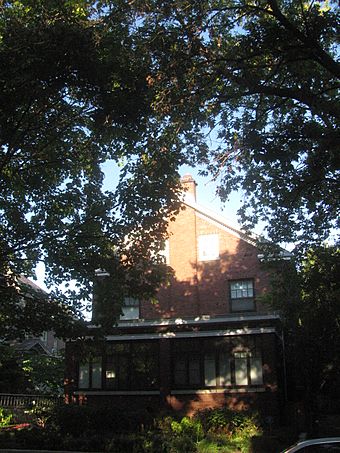Arthur H. Compton House facts for kids
|
Arthur H. Compton House
|
|
 |
|
| Location | 5637 South Woodlawn Ave., Chicago, IL |
|---|---|
| Area | less than one acre |
| Built | 1916 |
| NRHP reference No. | 76000687 |
Quick facts for kids Significant dates |
|
| Added to NRHP | May 11, 1976 |
| Designated NHL | May 11, 1976 |
The Arthur H. Compton House is a special historic home located at 5637 South Woodlawn Avenue in Chicago, Illinois. This house was built in 1905. From 1928 to 1945, it was the home of a very important scientist named Arthur Compton (1892–1962).
Arthur Compton made a huge discovery in 1923 called the Compton Effect. This discovery proved that light acts like both tiny particles and also like waves. For this amazing work, he won the Nobel Prize in Physics in 1927. Because of his importance, his house was named a National Historic Landmark in 1976.
The Arthur H. Compton House
The Arthur H. Compton House is in the Hyde Park area of Chicago. This neighborhood is close to the University of Chicago. The house is on the east side of South Woodlawn Avenue, between 56th and 57th Streets.
The house is a 2-1/2 story building made of brick. It has a sloped roof. A porch with a flat roof stretches across the front of the house. A chimney stands in front of the roof line. The main door is on the right side of the house. Inside, the house has a central hallway. It looks much like it did when Compton lived there.
Who Was Arthur Compton?
Arthur Compton was born in Wooster, Ohio. He studied at Wooster College and then at Princeton University. There, he earned his Ph.D. in physics.
In 1919, he traveled to England. He spent a year doing experiments with X-rays at Cavendish Laboratory. X-rays are a type of light that can pass through many materials. His work there helped him understand how X-rays interact with matter.
The Compton Effect: A Big Discovery
In 1923, Arthur Compton joined the faculty at the University of Chicago. He kept studying how X-rays "scatter," or bounce off, different materials. That same year, he published his famous paper about the Compton Effect.
This discovery was a big step in understanding light. It showed that light doesn't just act like a wave, as many thought. It also acts like tiny particles, which are like little packets of energy. This idea helped scientists understand the world at a very small, atomic level.
Later, Arthur Compton also supported the work of Enrico Fermi. Fermi was a scientist who worked on using nuclear power. Compton helped advance ways to use this new energy source for different purposes.




